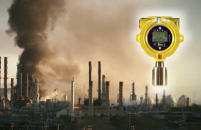Manufacturing plants, waste treatment centers, and refinery facilities are locations where certain chemicals are used to develop specialized products or to get rid of toxic compounds. In many cases, volatile organic compounds are a byproduct. If these gases escape into the atmosphere, the results could be catastrophic. This is why production facilities and industrial environments are required to monitor the air on a constant basis.
Volatile organic compounds – abbreviated as VOCs – leave a fingerprint when they are analyzed through the use of a specialized sensor that uses electrodes. When the sensor is calibrated to detect levels of a certain gas, the information is sent to a monitoring station that alerts personnel to the elevated amount of toxic gas in the vicinity.
About Volatile Organic Compounds
Certain solids and liquids give off gas vapors that are highly toxic. Some of these compounds are considered organic because they contain one or more of the so-called organic building blocks, namely oxygen, carbon, and hydrogen. Paints, solvents, cleaning fluids, and bonding agents are among those products containing VOCs.
Some VOCs are carcinogenic, meaning they can cause damage to human cells. To detect the presence of these gases, a VOC detector is used in the workplace. A network of sensors are placed at strategic locations, and these sensors are connected either by fiber communications lines or through wireless transmission to a central monitoring station and/or alarm monitor units. This allows workplace management to monitor the levels of any type of gas in areas where VOCs may be present in the indoor or outdoor atmosphere.
Types Of VOC Detection Systems
An outside contractor specializing in the development and manufacturing of gas monitors is called in to inspect the facility. Depending on the square footage and general layout of the refinery, chemical production plant, or waste treatment facility, a customized plan is drawn up that includes placement of a VOC detector network.
Likely gas leak locations include pipeline junctions, shutoff valves, gaskets, and enclosed mixing basins. The type of sensor used depends on the gases being produced. Electrode sensors use an electric current that interacts with a drawn sample of the air. The readout on the monitoring station panel shows the exact level of the gas. Open path systems use infrared light beams. The beam passes through the air, reflects off of a screen, and is directed to a monitor unit. The unit analyzes the received wavelength pattern and determines the level of any gas the monitor is calibrated to detect.
Worker Safety And The Environment
Regardless of the type of workplace, the health of employees is of prime concern. A gas leak can easily saturate a confined area. In waste treatment centers, escaping gas is at the mercy of the prevailing winds. This is why detection of even slightly elevated amounts of VOCs must be detected immediately.
When properly installed, a VOC detector array automatically shuts down equipment and provides visual and audio alarms when high levels of toxic gases occur. The location of the gas is quickly pinpointed so that the cause of the leak can be accurately determined. Industrial environments cannot afford to operate without this type of detection system in place.

